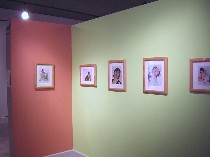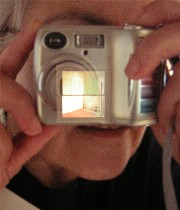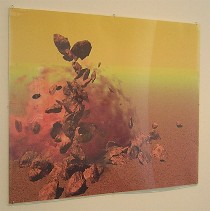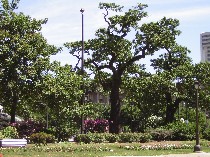 Save the evening of Saturday, July 17 for one of L.U.R.E.‘s video projects, to take place in the courtyard at Moore College. I learned this from Director of Exhibitions Brian Wallace, when I stopped in this morning to see “Philadelphia Selections Five” (see Roberta’s thumbs-up post on the show and the top two images here*). Wallace said the upcoming event was a combination of music and video presented by L.U.R.E. and the New Humans (from New York).
Save the evening of Saturday, July 17 for one of L.U.R.E.‘s video projects, to take place in the courtyard at Moore College. I learned this from Director of Exhibitions Brian Wallace, when I stopped in this morning to see “Philadelphia Selections Five” (see Roberta’s thumbs-up post on the show and the top two images here*). Wallace said the upcoming event was a combination of music and video presented by L.U.R.E. and the New Humans (from New York).
 Other future plans at Moore include something with Barnaby Furnas (a hit at this year’s Whitney Biennial) and a show of work by Brazilian artist Artur Barrio, both in the 2005-2006 season. For 2004-05, Wallace said he has on tap a show of recent videos from Janet Biggs, whose work has a lot of athleticism and sports imagery; he’s also expecting a show on the Lewis and Clark Expedition, organized by the Tacoma Art Museum.
Other future plans at Moore include something with Barnaby Furnas (a hit at this year’s Whitney Biennial) and a show of work by Brazilian artist Artur Barrio, both in the 2005-2006 season. For 2004-05, Wallace said he has on tap a show of recent videos from Janet Biggs, whose work has a lot of athleticism and sports imagery; he’s also expecting a show on the Lewis and Clark Expedition, organized by the Tacoma Art Museum.
Explosions

Wallace also curated a show of digital images he received via e-mail from Dilovan Amin, an Iraqi artist from Dukok, Kurdistan.
The explosions seem clinical, a trick of quick-trigger photography, somehow distilling fear and thunder into a visual ballet of falling walls and dust. The photos make the terror of war manageable.
While I thought many of them beautiful, they didn’t bring me to feelings of vulnerability or any other such sympathetic reaction–just wonder–so that’s how walls fly apart when they are detonated. Part of this may be explained by choosing walls that looked isolated, without connection to home or office or other daily space.
 Even so, I was happy to get away from the images and return to Logan Circle and my peaceful Philadelphia (right).
Even so, I was happy to get away from the images and return to Logan Circle and my peaceful Philadelphia (right).Wallace said that before America invaded, he had contacted a number of artists in Iraq, and since then they have been sending him emails with artwork.
*Top image is from chronicler of American taste Elizabeth Rywelski, who has pushed a step further her K-Mart photo portraits of herself, dressed for the shoot by K-Mart employees; this time, in her search for how to fit in to the American scene, she hung the portraits on wall treatments selected by Home Depot shoppers with whom she stood in line.
The next image is from James Johnson, whose peepholes through mirrors allow you to peer into behind-the-wall spaces. (Yes, I’m afraid that’s me again, caught in the mirror, but I couldn’t figure out how to take this photo any other way). Johnson said the mirrors followed some earlier work using black glass, and that he was influenced by David Hockney’s book “Secret Knowledge: Rediscovering the Lost Techniques of the Old Masters.” But the tricks in Johnson’s installation, which he kindly reveals if you go around to the back of it, are anything but Old Masters-ish. Neither are the little interiors he has chosen. Take a peek.









